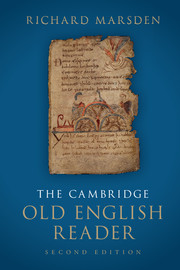159 results
Biological richness of Gunung Slamet, Central Java, and the need for its protection—CORRIGENDUM
-
- Article
-
- You have access
- Open access
- HTML
- Export citation
Biological richness of Gunung Slamet, Central Java, and the need for its protection
-
- Article
-
- You have access
- Open access
- HTML
- Export citation
Jane Hawkes and Meg Boulton , eds. All Roads Lead to Rome: The Creation, Context and Transmission of the Codex Amiatinus. Studia Traditionis Theologiae: Explorations in Early and Medieval Theology 31. Turnhout: Brepols, 2019. Pp. 220. $98.00 (cloth).
-
- Journal:
- Journal of British Studies / Volume 59 / Issue 4 / October 2020
- Published online by Cambridge University Press:
- 07 October 2020, pp. 898-900
- Print publication:
- October 2020
-
- Article
- Export citation
The Psalms and medieval English literature. From the conversion to the Reformation. Edited by Tamara Atkin and Francis Leneghan. Pp. xviii + 344 incl. 18 figs and 16 tables. Cambridge: D. S. Brewer, 2017. £60. 978 1 84384 435 8
-
- Journal:
- The Journal of Ecclesiastical History / Volume 69 / Issue 4 / October 2018
- Published online by Cambridge University Press:
- 15 October 2018, pp. 847-848
- Print publication:
- October 2018
-
- Article
- Export citation
34 - Strategic Bidding in Combinatorial Clock Auctions – A Bidder Perspective
- from Part V - The Bidders’ Perspective
-
-
- Book:
- Handbook of Spectrum Auction Design
- Published online:
- 26 October 2017
- Print publication:
- 26 October 2017, pp 748-763
-
- Chapter
- Export citation
30 - The Battle of Maldon
- from V - Telling tales
-
- Book:
- The Cambridge Old English Reader
- Published online:
- 28 May 2018
- Print publication:
- 02 April 2015, pp 287-305
-
- Chapter
- Export citation
36 - Deor
- from VI - Reflection and lament
-
- Book:
- The Cambridge Old English Reader
- Published online:
- 28 May 2018
- Print publication:
- 02 April 2015, pp 365-369
-
- Chapter
- Export citation
22 - A Homily for Easter Sunday (from Ælfric's Sermones catholicae)
- from IV - Example and exhortation
-
- Book:
- The Cambridge Old English Reader
- Published online:
- 28 May 2018
- Print publication:
- 02 April 2015, pp 217-227
-
- Chapter
- Export citation
18 - The Drowning of Pharaoh's Army (Exodus, lines 447–564)
- from III - Spreading the word
-
- Book:
- The Cambridge Old English Reader
- Published online:
- 28 May 2018
- Print publication:
- 02 April 2015, pp 174-182
-
- Chapter
- Export citation

The Cambridge Old English Reader
-
- Published online:
- 28 May 2018
- Print publication:
- 02 April 2015
-
- Textbook
- Export citation
The writing and pronunciation of Old English
-
- Book:
- The Cambridge Old English Reader
- Published online:
- 28 May 2018
- Print publication:
- 02 April 2015, pp 403-408
-
- Chapter
- Export citation
Guide to terms
-
- Book:
- The Cambridge Old English Reader
- Published online:
- 28 May 2018
- Print publication:
- 02 April 2015, pp 571-578
-
- Chapter
- Export citation
I - Teaching and learning
-
- Book:
- The Cambridge Old English Reader
- Published online:
- 28 May 2018
- Print publication:
- 02 April 2015, pp 37-39
-
- Chapter
- Export citation
32 - The Fight at Finnsburh
- from V - Telling tales
-
- Book:
- The Cambridge Old English Reader
- Published online:
- 28 May 2018
- Print publication:
- 02 April 2015, pp 334-340
-
- Chapter
- Export citation
25 - The Sermon of the Wolf (Wulfstan's Sermo Lupi)
- from IV - Example and exhortation
-
- Book:
- The Cambridge Old English Reader
- Published online:
- 28 May 2018
- Print publication:
- 02 April 2015, pp 245-256
-
- Chapter
- Export citation
40 - The Wife's Lament
- from VI - Reflection and lament
-
- Book:
- The Cambridge Old English Reader
- Published online:
- 28 May 2018
- Print publication:
- 02 April 2015, pp 387-392
-
- Chapter
- Export citation
33 - Truth is Trickiest (Maxims II)
- from VI - Reflection and lament
-
- Book:
- The Cambridge Old English Reader
- Published online:
- 28 May 2018
- Print publication:
- 02 April 2015, pp 344-349
-
- Chapter
- Export citation
37 - The Ruin
- from VI - Reflection and lament
-
- Book:
- The Cambridge Old English Reader
- Published online:
- 28 May 2018
- Print publication:
- 02 April 2015, pp 370-374
-
- Chapter
- Export citation
26 - The Seafarer
- from IV - Example and exhortation
-
- Book:
- The Cambridge Old English Reader
- Published online:
- 28 May 2018
- Print publication:
- 02 April 2015, pp 257-266
-
- Chapter
- Export citation
Contents
-
- Book:
- The Cambridge Old English Reader
- Published online:
- 28 May 2018
- Print publication:
- 02 April 2015, pp v-viii
-
- Chapter
- Export citation



